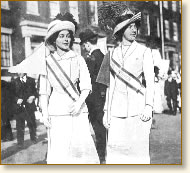Women Win the Vote
The demand for woman's suffrage was first introduced in the U.S. at the First
Women's Right's Convention, 1848 in Seneca Falls, N.Y. Elizabeth Cady Stanton,
one of the organizers of the meeting, introduced the resolution of women's suffrage
knowing full well that it would be considered by the attendees as too radical.
Frederick Douglas spoke to the convention, endorsing the Declaration of Sentiments
which demanded rights for
 |
Two "Suffragists" demonstrate
At a Washington, DC rally
1912 |
women - - property rights, education rights, employment,
rights over their own children, and the right to vote. The Declaration of Sentiments
was signed by 100 attendants, but it was to take 72 years of continuous struggle
and effort before the 19th Amendment to the Constitution was approved.
Many feminists were abolitionists and fought for the rights of blacks to vote,
believing that this struggle would include all blacks, and women - - all women.
The 15th amendment, however, excluded women and caused a rift among feminists.
Many women felt that once the black man could vote, women's voting rights would
soon follow. Susan Anthony and Elizabeth Cady Stanton and others would not
endorse the amendment, because it did not include women.
Two organizations resulted - - The National Woman Suffrage Association, which worked on the federal level to secure suffrage and other rights for women; and the National American Woman Suffrage Association (NAWSA) which targeted states for securing the ballot. Alice Paul was forced to resign from NAWSA because she believed in direct tactics. She organized the National Woman's Party, using strategies such as mass marches and hunger strikes. The efforts of both parties led to the passage of the 19th Amendment (The Anthony Amendment) on August 26, 1920 which states: the rights of citizens to vote: "shall not be denied or abridged by the U.S. or by any State on account of sex."
How To Cite This Article:
"Women Win the Vote," EyeWitness to History, www.eyewitnesstohistory.com (2000).
|






